With a TVL of $3.5 billion and an order book depth exceeding that of CEX, Hyperliquid holds a 73% market share.
- 核心观点:Hyperliquid 巩固去中心化永续合约市场领导地位。
- 关键要素:
- TVL 达35亿美元,增长70.8%。
- 未平仓合约量150亿美元,增长359%。
- HYPE代币年化收入8.1亿美元。
- 市场影响:推动去中心化交易新格局。
- 时效性标注:中期影响。
Original Title: Semiannual Report: "Inside Hyperliquid's Growth"
Compiled by: Odaily Planet Daily Asher ( @Asher_0210 )
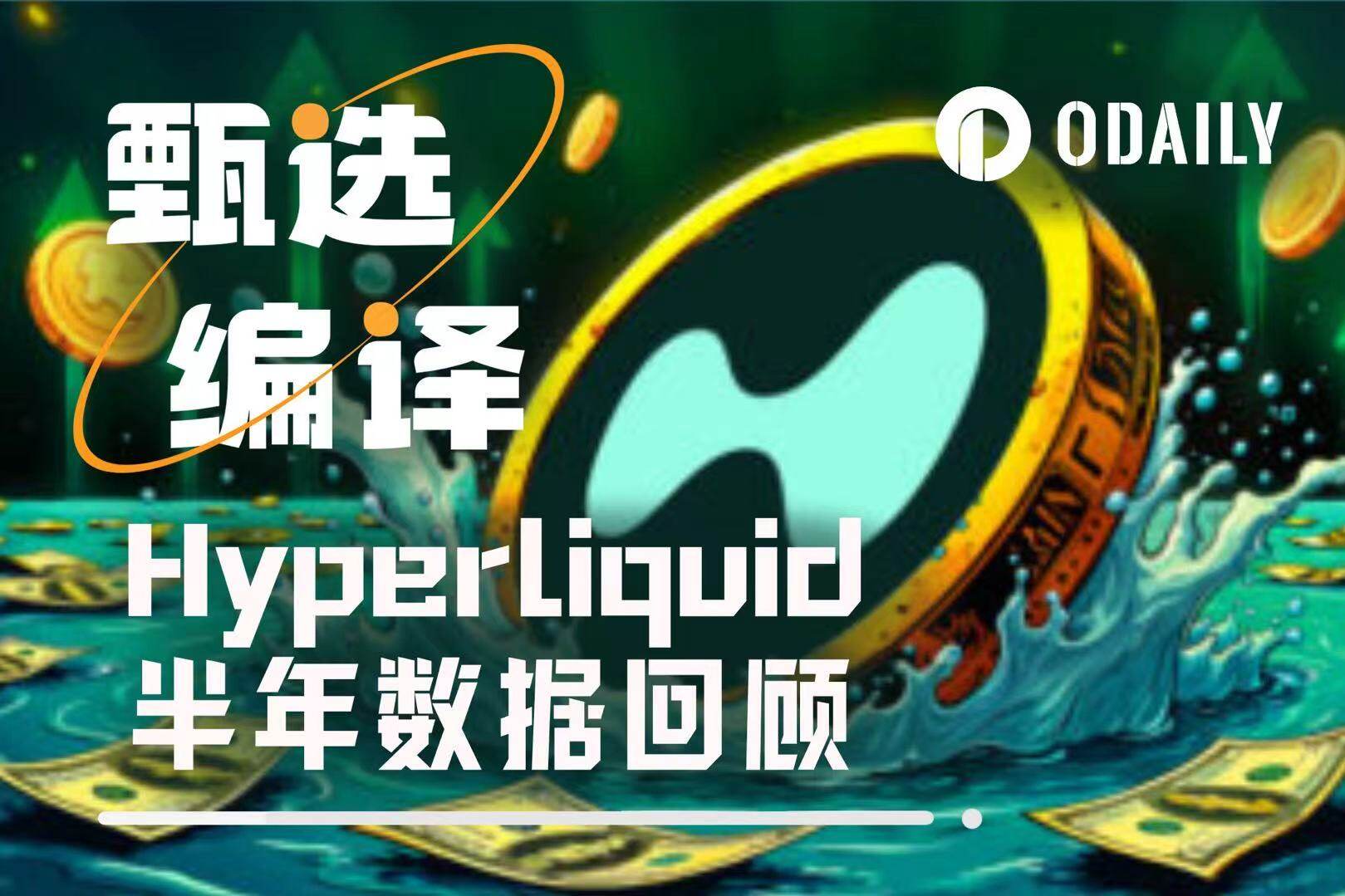
Editor's Note: In the first half of 2025, Hyperliquid maintained its leading position in the decentralized perpetual swap market, achieving record highs in TVL, open interest, and trading volume. The HyperEVM ecosystem expanded rapidly, Unit facilitated the implementation of spot trading, and native apps and Builder Codes accelerated user growth. The HYPE token performed reliably, supported by a unique buyback mechanism and record revenue. Meanwhile, HIP-3, which opens up perpetual market deployment, presents new profit opportunities for the community. With the addition of strategic partners and the onboarding of more assets, Hyperliquid has significant growth potential in the second half of the year and is shaping a new landscape for decentralized trading.
Hyperliquid On-Chain Metrics
TVL and Capital Inflow
The launch and airdrop of the HYPE token did not lead to user churn. Instead, Hyperliquid experienced astonishing growth starting in Q4 2024. In November, inflows surged, reaching a daily peak of over $50 million, pushing TVL from $564 million to over $2 billion, a 269% quarterly growth rate.
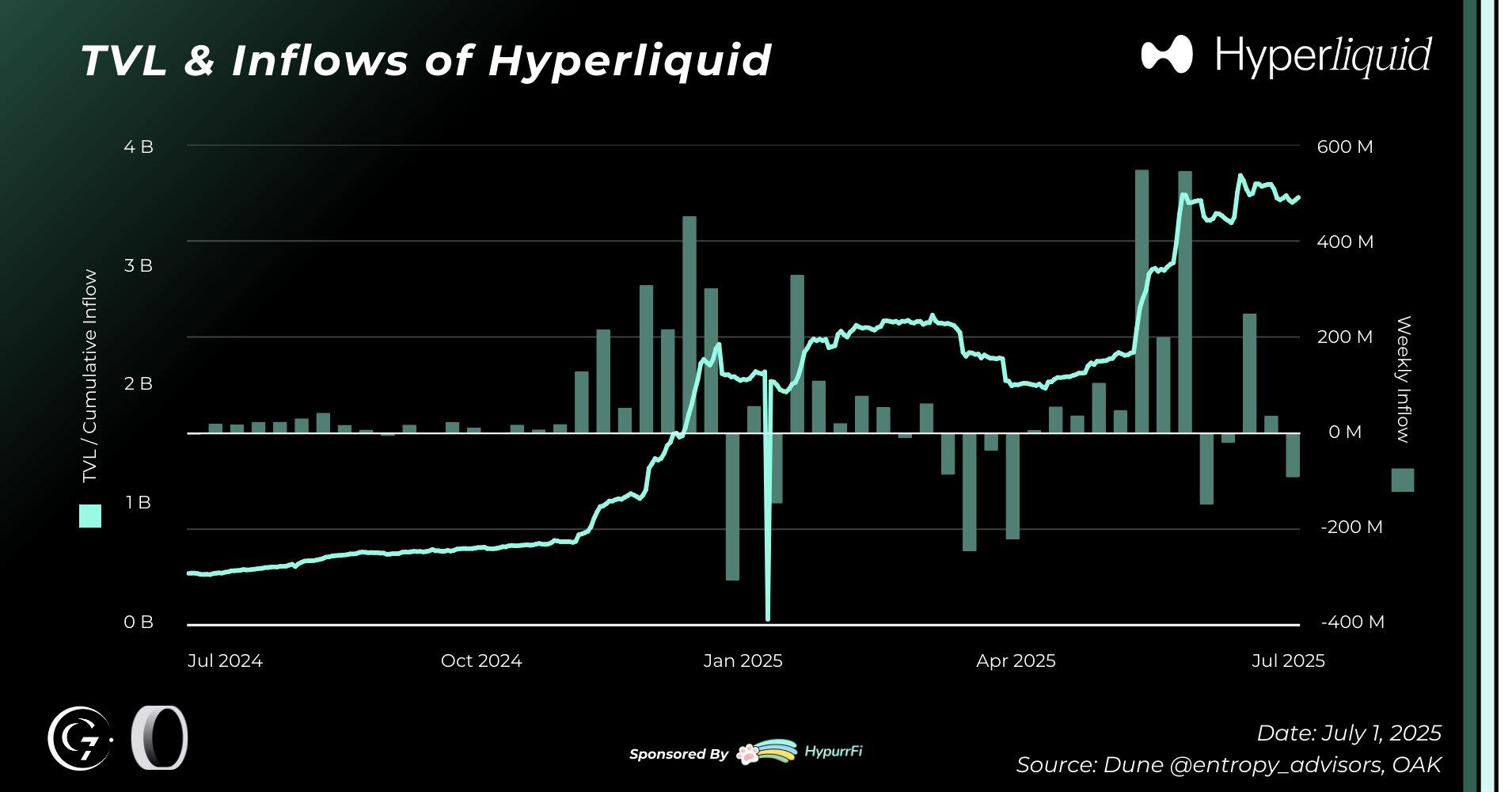
Thanks to this continued growth, Hyperliquid further solidified its dominance in the decentralized perpetual contract trading space in the first half of 2025. As of June 30, the platform's TVL reached $3.5 billion, a 70.8% increase from $2.1 billion at the beginning of the year. During the same period, despite experiencing a net outflow of $590 million in March, overall capital inflows remained strong, averaging $58 million per week.
Open interest and trading volume
Hyperliquid's open interest grew by approximately 227% in just a few months, first exceeding $1 billion in Q4 2024 and reaching $3.27 billion by the end of the year. This figure continued to soar in 2025, currently reaching $15 billion, a 359% year-over-year increase from the end of 2024. This represents 61% of ByBit's, 105% of OKX's, and 120% of Bitget's.
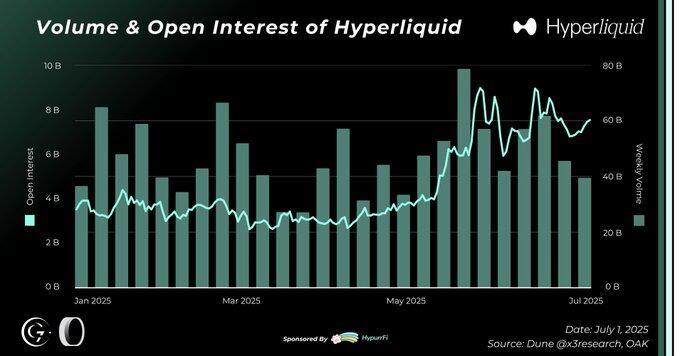
In Q4 2024, Hyperliquid's weekly trading volume reached approximately $13 billion. This figure significantly increased to an average of $47 billion in the first half of 2025, reaching a record high of $78 billion during the week of May 12. Meanwhile, its market share also expanded, rising from approximately 56% of decentralized perpetual swap trading platforms at the end of 2024 to over 73% by the end of Q1 2025, further solidifying its dominant position in the industry.
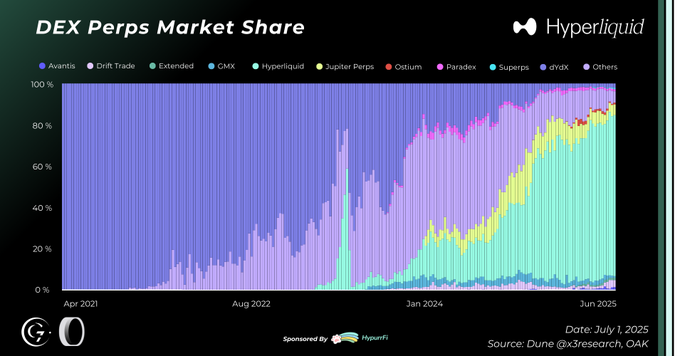
In terms of user scale, Hyperliquid's user addresses grew from 291,000 to over 518,000 in the first half of 2025, a 78% increase in six months. This growth not only reflects the rapid expansion of the platform's user base, but also corresponds to over $53 billion in liquidated positions, demonstrating the activeness and depth of market activity.
Hyperliquid and CEX data comparison
Hyperliquid’s growth relative to centralized exchanges (CEX) has been particularly strong in the first half of 2025, with:
- Hyperliquid's trading volume accounted for 6.1%, an increase of 3.9 percentage points from January this year.
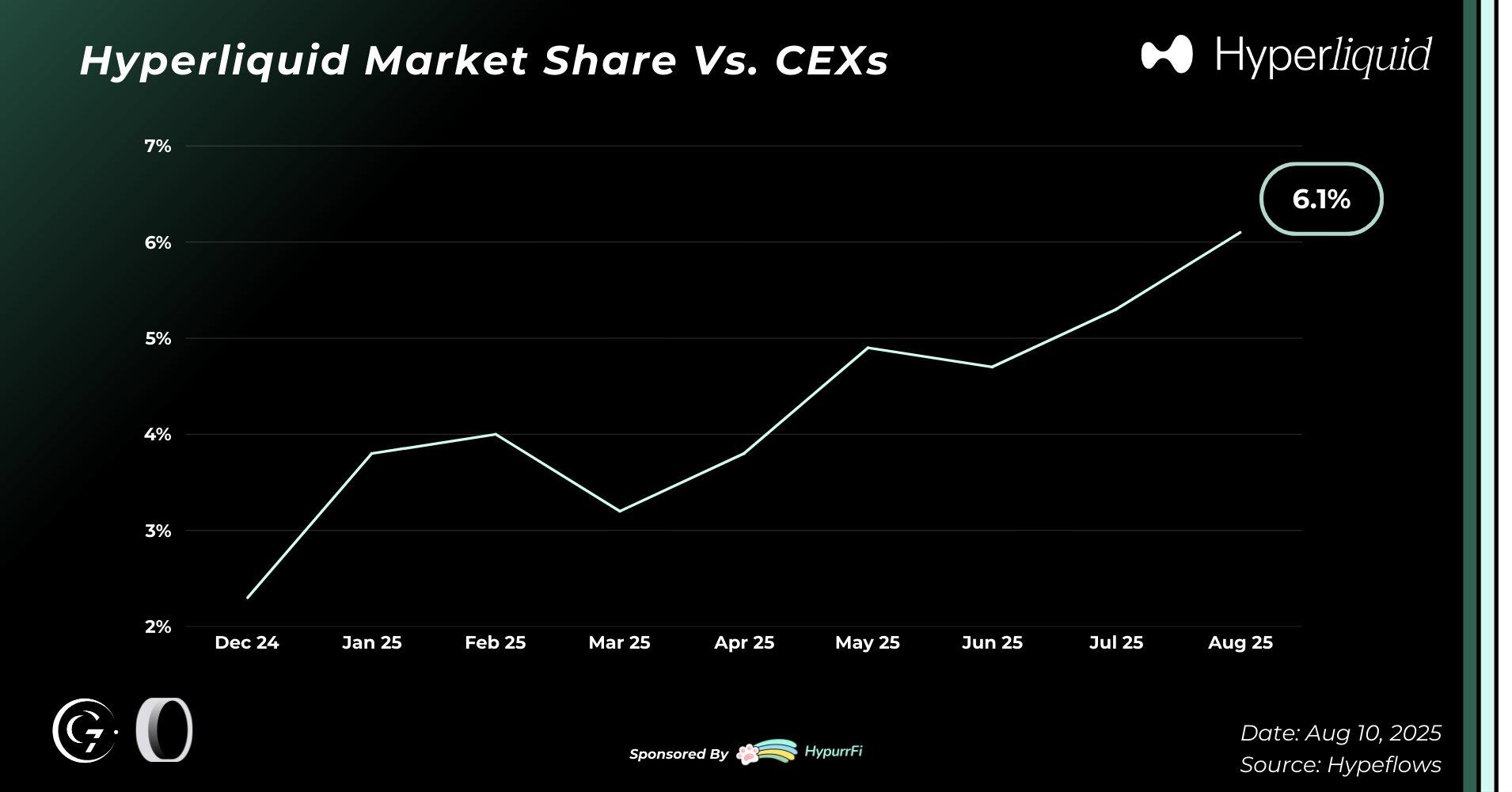
- Hyperliquid's open interest accounted for 17.8%, up 12.3 percentage points from January this year.
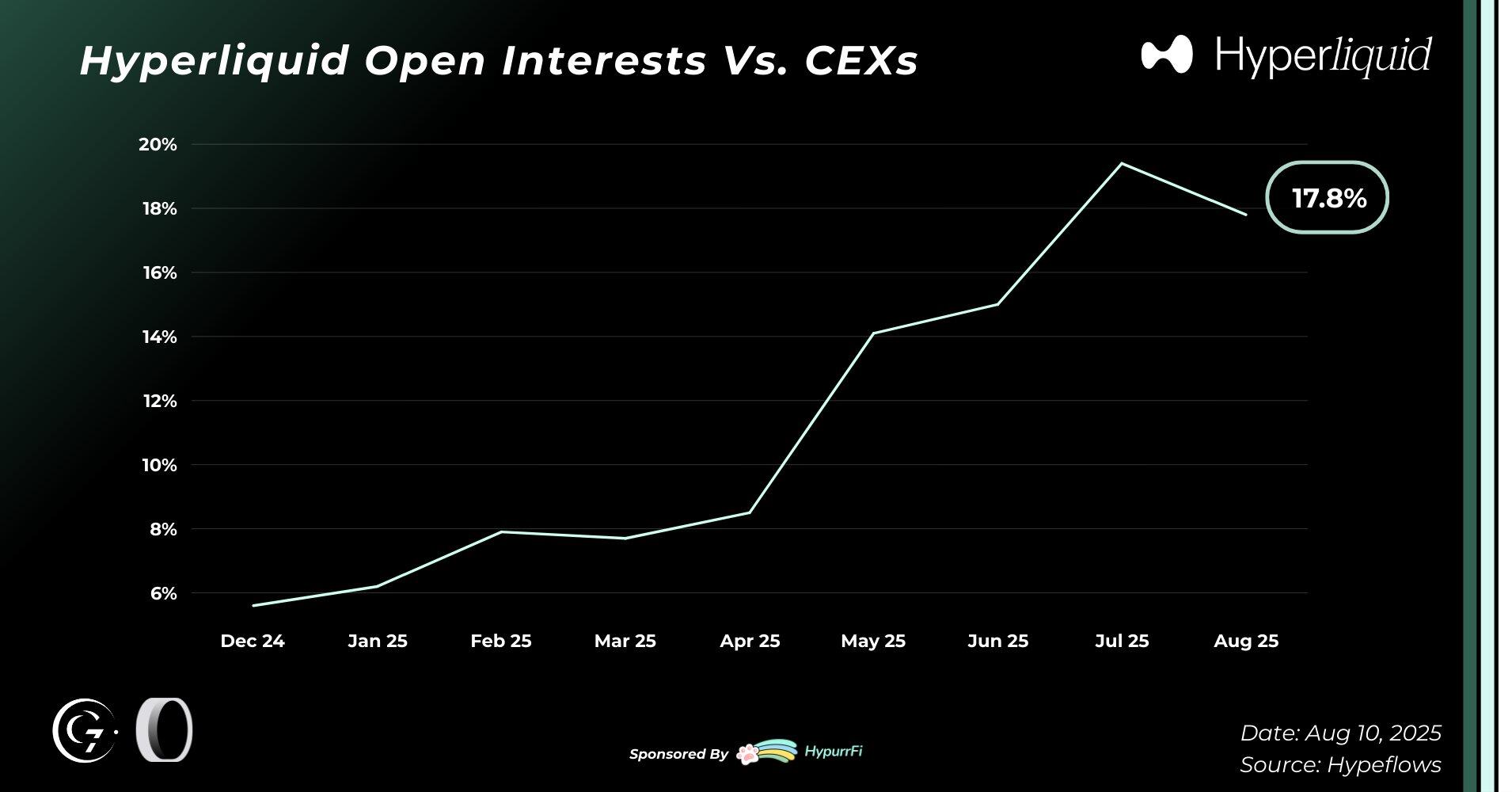
First, Hyperliquid offers the lowest cost for trading spot and perpetual contracts in the ecosystem, while providing deep on-chain liquidity. For some assets, order book depth rivals that of leading CEXs. For example, during the launch of PUMP, the platform achieved the deepest market depth, highest trading volume, and tightest bid-ask spreads—a record for DEXs.
Secondly, Hyperliquid has become the preferred platform for new coin launches. Since the launch of Trump Coin, the platform has consistently been the first to launch perpetual contracts. This strategy has rapidly attracted users and reinforced the platform's reputation as the preferred choice for new coin trading. Furthermore, PUMP raised approximately $500 million in just 12 minutes after its launch. Hyperliquid was the first platform to simultaneously launch spot and perpetual contracts, providing pre-trading opportunities, demonstrating its ability to attract users and generate liquidity.
Today, Hyperliquid matches leading CEXs in transaction speed, liquidity, and user experience, while retaining the advantages of decentralization: permissionless access, on-chain transparency, and native composability, allowing any asset, position, or transaction to be directly integrated with smart contracts, dApps, or other protocols on the HyperEVM.
HLP: Core liquidity engine and stable returns
Hyperliquidity Provider (HLP) is Hyperliquid's core liquidity engine, providing USDC liquidity for order books, market making, and automated liquidations, while also aggregating returns from various strategies to offer users non-directional exposure. HLP TVL surges by the end of 2024, driven by the HYPE airdrop, from $150 million at the end of November to over $400 million by early 2025. It peaked at $512 million in May and remained stable throughout the first half of the year, ultimately closing at $372 million.
During the same period, HLP's net profit increased from $50 million to $68 million, with an average annualized return for users of approximately 11%. Despite the JELLY incident ( click here to read more about the incident ), net returns in the first quarter of 2025 were still 5.2%, a decline of less than 3.5%.
Unit: The key to Hyperliquid's future
Unit was launched on February 14, 2025. It is Hyperliquid's asset tokenization layer. It supports native deposits and withdrawals of multiple assets, and directly lists assets on the Hyperliquid spot market through an auction system. It initially supported BTC and later expanded to ETH, SOL, FARTCOIN, PUMP, BONK, etc.
Since its launch, Unit's TVL has reached $800 million, second only to Kinetiq; over $15 billion in assets were traded through Unit in the first half of the year. Despite this, Hyperliquid's spot trading volume still only accounts for 2% of total trading volume, far lower than the 15%–30% share of most centralized exchanges, indicating that it's still in its early stages.
HyperEVM on-chain metrics
HyperEVM was launched in February 2025. The blockchain is EVM-compatible and built directly on Hyperliquid's infrastructure, supporting the deployment of smart contracts and decentralized applications.
TVL
Although TVL was less than $50 million in early February, just two months after the mainnet deployment (mid-April), TVL exceeded $1 billion and reached $2.08 billion on June 30, doubling its value.
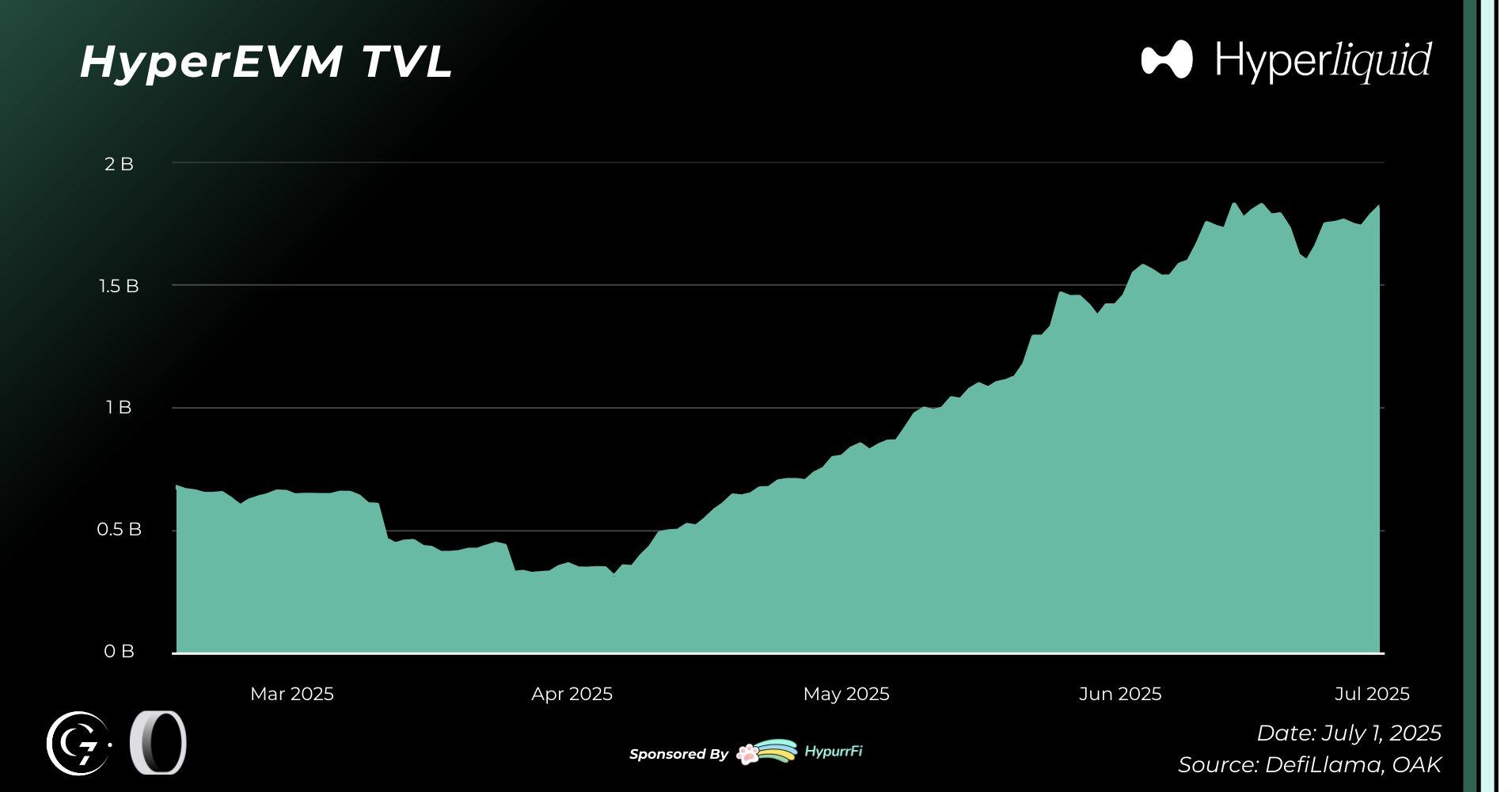
Number of active addresses
In the first half of 2025, HyperEVM user activity steadily increased, with an average of approximately 33,000 daily active addresses, and exceeding 44,000 in the peak week of June.

In addition, transaction volume showed a similar trend, averaging approximately 208,000 transactions per day and reaching a peak of 315,000 transactions.
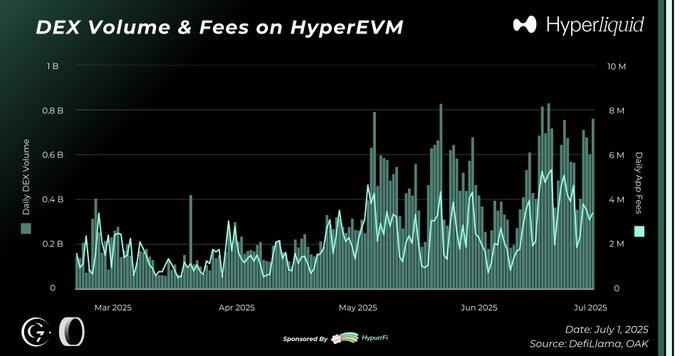
In terms of economic performance, applications on HyperEVM generated an average of approximately $1.927 million in fees per day, with a peak of $4.855 million on May 21. As of now, the total fees have accumulated to $256.2 million.
HYPE Revenue and Buybacks
Unlike most DeFi protocols, the Hyperliquid team does not directly receive platform fees. All revenue is allocated to HLP and the Assistance Fund. HLP is the community treasury that provides market-making returns to users; the Assistance Fund, denominated in HYPE, serves as a liquidity reserve when needed.
Data from recent months indicates that approximately 92% of fees go to the Assistance Fund, with the remaining 8% allocated to HLP. Through the HYPE buyback program, the Assistance Fund uses revenue to repurchase tokens in the spot market, thereby supporting the HYPE price and directly benefiting token holders.
Since the beginning of 2025, Hyperliquid has generated $406 million in total revenue (over $810 million annualized), making it one of the most profitable protocols in the crypto industry, behind only Tether and Circle. Fees increased significantly in the first quarter, rising from approximately $1 million per day to an average of $3 million, with peaks exceeding $5 million.
Additionally, the Assistance Fund repurchases approximately 13% of the HYPE supply annually, and Hyperliquid fees will increase further as HIP-3 and builder code (represented by Phantom) go live, thereby reinforcing the repurchase model and supporting token value (at the time of writing, based on data from the past 30 days, annualized revenue is approximately $1 billion, which means a price-to-earnings ratio of approximately 15 based on circulating supply).
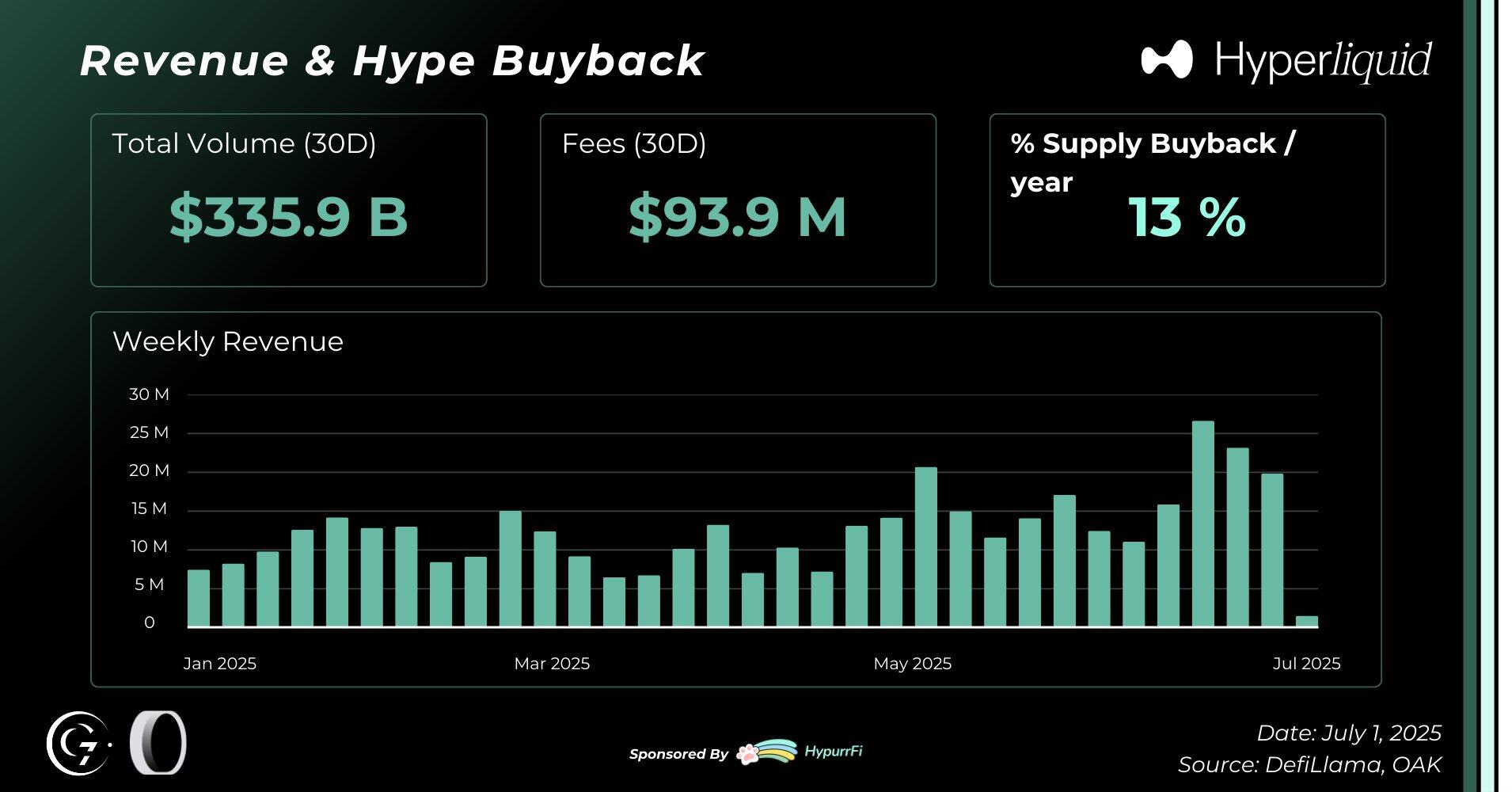
Hyperliquid's key events in the first half of the year
In January 2025, Hyperliquid expanded the number of validators to 27 and launched the TRUMP perpetual contract, with trading volume exceeding US$21 billion for two consecutive days.
In February 2025, Unit was launched, achieving a native asset recharge of US$400 million and a spot trading volume of US$8.4 billion; HyperEVM was launched, and TVL reached US$2 billion.
In March 2025, the Jelly incident caused HLP to lose $12 million, and users received compensation.
In May 2025, the HIP-3 testnet allowed the community to deploy new perpetual markets, while also launching Staking Tiers and new stablecoins USDe and USDT0.
By June 2025, several public companies had added HYPE to their corporate coffers, with Hyperliquid's annualized revenue exceeding $800 million, 97% of which was used for HYPE repurchases.
In July 2025, CoreWriter was launched to achieve bidirectional writability between HyperCore and HyperEVM, Builder Codes integrated Phantom Perps, and about 20,000 new users were added, with an estimated annual revenue of US$15 million to US$30 million.
summary
In the first half of 2025, Hyperliquid continued to solidify its leadership in the decentralized perpetual swap market, with strong on-chain performance across various metrics, accelerated HyperEVM adoption, and a rapidly expanding native application ecosystem. The robust performance of the HYPE token, supported by a unique buyback mechanism and record revenue, demonstrates the sustainability of the protocol's economic model.
More broadly, Hyperliquid is continuously opening up new growth opportunities by strengthening its liquidity and infrastructure advantages while promoting the development of HIP-3, CoreWriter, and Builder Codes. With the addition of strategic partners such as Phantom and the rise of the HyperEVM native protocol, the network has the potential for solid growth in the second half of the year.
HIP-3 is the core driving force: any user holding 1 million HYPE can deploy perpetual contracts and earn up to 50% in transaction fees, without the burden of infrastructure development, with Hyperliquid providing full support. Phantom integration is already showing initial success, with this integration alone expected to generate 2%–4% annualized cash flow growth. The potential will be further amplified if more wallets and front-ends follow suit.
With the US SEC launching a new blockchain asset plan, Hyperliquid is expected to support more asset types and unlock more growth opportunities.



